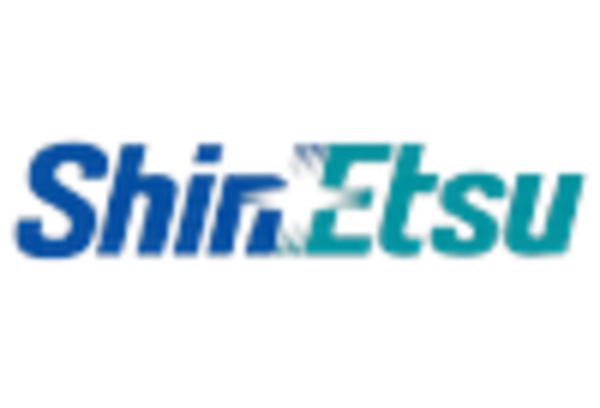Rising Demand for Electric Vehicles
The increasing demand for electric vehicles (EVs) is a primary driver in the Silicone in Electric Vehicle Market. As consumers become more environmentally conscious, the shift towards EVs accelerates. In 2025, the number of electric vehicles on the road is projected to surpass 30 million units, indicating a robust growth trajectory. This surge necessitates the use of advanced materials, including silicone, which offers superior thermal stability and electrical insulation. Silicone's properties are particularly advantageous in battery management systems and electronic components, enhancing performance and safety. Consequently, manufacturers are increasingly integrating silicone into their designs to meet the evolving needs of the market.
Emergence of Smart Vehicle Technologies
The emergence of smart vehicle technologies is reshaping the Silicone in Electric Vehicle Market. As vehicles become more connected and autonomous, the demand for advanced materials that can support these technologies is increasing. Silicone's versatility allows it to be used in various applications, from sensors to communication devices within electric vehicles. The market for smart vehicle technologies is expected to grow substantially, with projections indicating a potential increase in market size by over 15% annually through 2025. This growth presents opportunities for silicone manufacturers to innovate and develop specialized products that cater to the unique requirements of smart electric vehicles.
Regulatory Support for Electric Mobility
Regulatory support for electric mobility is a crucial factor propelling the Silicone in Electric Vehicle Market. Governments worldwide are implementing stringent emissions regulations and providing incentives for EV adoption. For instance, many regions are setting ambitious targets for phasing out internal combustion engines, which is expected to boost the electric vehicle market significantly. This regulatory environment encourages manufacturers to invest in innovative materials like silicone, which can enhance the performance and longevity of EV components. As policies continue to evolve, the demand for silicone in electric vehicles is anticipated to rise, aligning with the broader goals of sustainability and reduced carbon emissions.
Technological Advancements in Battery Systems
Technological advancements in battery systems are significantly influencing the Silicone in Electric Vehicle Market. Innovations such as solid-state batteries and improved lithium-ion technologies require materials that can withstand higher temperatures and provide better insulation. Silicone, with its excellent thermal and electrical properties, is becoming a preferred choice for encapsulating battery components. The market for EV batteries is expected to grow at a compound annual growth rate of over 20% through 2025, further driving the demand for silicone-based solutions. As manufacturers strive for efficiency and safety in battery design, the role of silicone is likely to expand, positioning it as a critical material in the evolving landscape of electric vehicles.
Growing Focus on Vehicle Safety and Performance
The growing focus on vehicle safety and performance is driving the Silicone in Electric Vehicle Market. As electric vehicles become more mainstream, consumers are increasingly concerned about the safety features and overall performance of these vehicles. Silicone materials are known for their durability and resistance to environmental factors, making them ideal for critical components such as seals, gaskets, and insulation. The automotive industry is projected to invest heavily in safety technologies, with a significant portion allocated to enhancing the performance of electric vehicles. This trend suggests that silicone will play a vital role in meeting safety standards and improving the overall driving experience.
















Leave a Comment